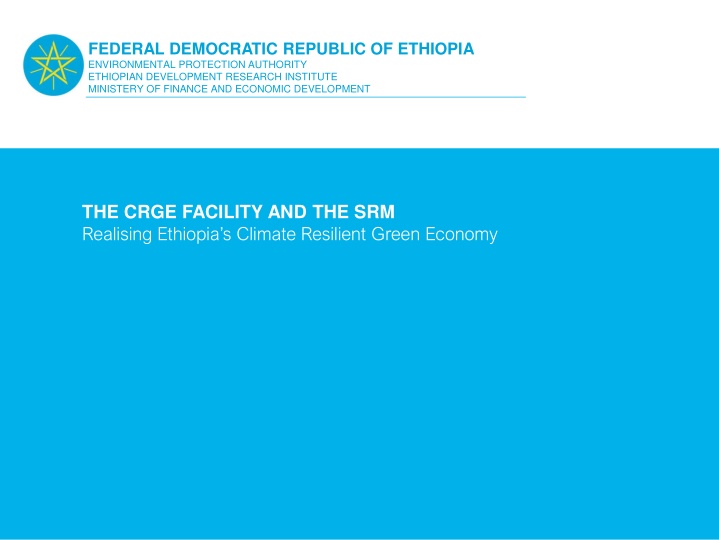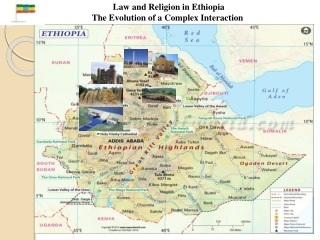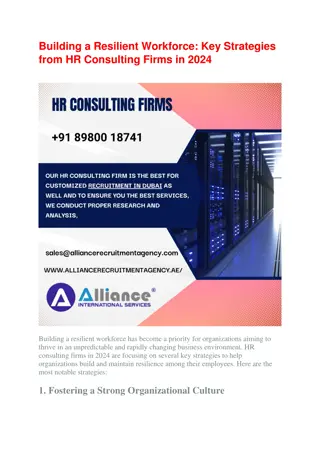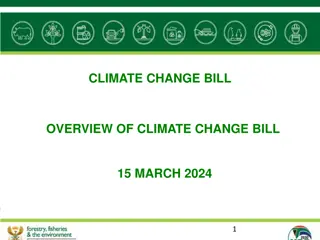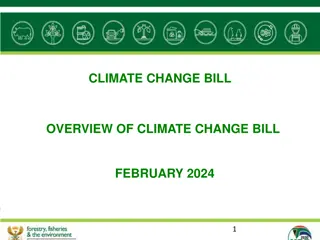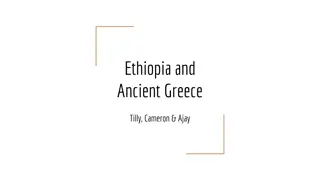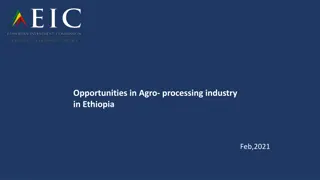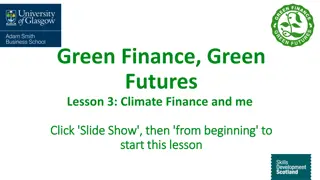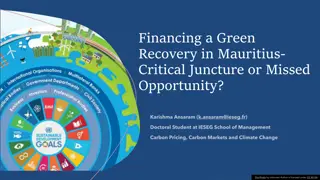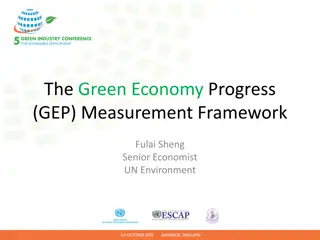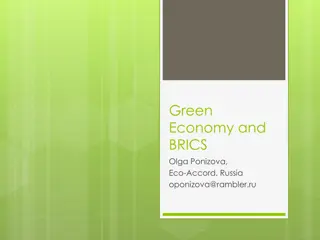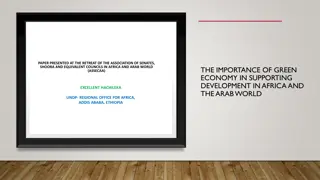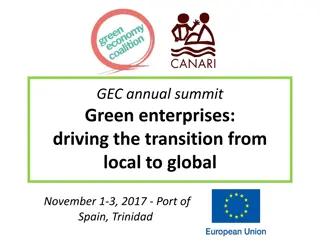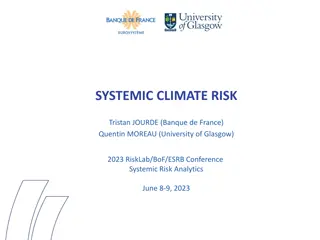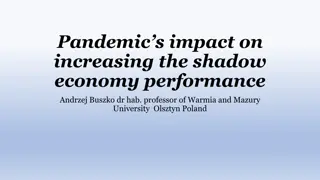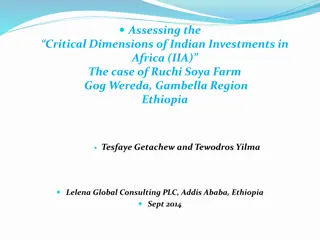Building Ethiopia's Climate Resilient Green Economy
Federal Democratic Republic of Ethiopia aims to achieve a middle-income climate resilient green economy by 2025 through zero net carbon growth. The Climate Resilient Green Economy (CRGE) initiative focuses on reducing emissions, mobilizing finance, and enhancing capacity to combat climate change impacts.
Download Presentation

Please find below an Image/Link to download the presentation.
The content on the website is provided AS IS for your information and personal use only. It may not be sold, licensed, or shared on other websites without obtaining consent from the author.If you encounter any issues during the download, it is possible that the publisher has removed the file from their server.
You are allowed to download the files provided on this website for personal or commercial use, subject to the condition that they are used lawfully. All files are the property of their respective owners.
The content on the website is provided AS IS for your information and personal use only. It may not be sold, licensed, or shared on other websites without obtaining consent from the author.
E N D
Presentation Transcript
FEDERAL DEMOCRATIC REPUBLIC OF ETHIOPIA ENVIRONMENTAL PROTECTION AUTHORITY ETHIOPIAN DEVELOPMENT RESEARCH INSTITUTE MINISTERY OF FINANCE AND ECONOMIC DEVELOPMENT THE CRGE FACILITY AND THE SRM Realising Ethiopia s Climate Resilient Green Economy
THE VISION FEDERAL DEMOCRATIC REPUBLIC OF ETHIOPIA To build a middle-income climate resilient green economy by 2025 through zero net carbon growth GREEN ECONOMY (GE) CLIMATE RESILIENT (CR) 1. Climate change results in changes to weather which will impact across the whole economy. 1. Ethiopia is committed to be a middle income country by 2025 (USD $1000 GDP per capita) 1. Development ambition is laid out in the Growth and Transformation Plan (GTP) 2. A climate resilient economy will be protected from the negative impacts of climate change and seek opportunities in a changing climate. 1. A commitment to foster zero net carbon growth 1. Builds on and incorporates the Ethiopia s Program of Adaptation to Climate Change (EPACC) and other relevant analysis. Reference in SRM document: Sections 2 (the context) and 3 (the barriers) 1. This low carbon growth create employment and provide wider socio-economic benefits.
THE CRGE INITIATIVE FEDERAL DEMOCRATIC REPUBLIC OF ETHIOPIA The CRGE Initiative was created to achieve the overarching vision of a climate resilient and green economy LED BY EPA and MOFED LED BY EPA SECTORAL REDUCTION MECHANISM DUE FOR COMPLETION IN MARCH 2013 FACILITY (FINANCE) STRATEGY CLIMATE RESILIENT GREEN ECONOMY CLIMATE RESILIENT VISION GREEN ECONOMY LED BY EPA COMPLETED IN SEPT 2011 REGISTRY (ACTIONS) LED BY EPA LED BY EPA COMPLETED IN SEPT 2011 KNOWLEDGE MANAGEMENT ANALYSIS & POLICY COORDINATION FINANCE MRV CAPACITY BUILDING SUPPORT LED BY EPA FINANCE Reference in SRM document: Sections 5.1 (establishment of a register) and 5.2 (the CRGE facility)
THE CRGE FACILITY FEDERAL DEMOCRATIC REPUBLIC OF ETHIOPIA The CRGE Facility was created to finance the implementation of the CRGE, it is a bank housed within MOFED which will convert to a Green Investment Bank CRGE FACILITY OBJECTIVES Help mobilize finance required for implementing the CRGE. Sources of finance will come from government, private finance, development partners, carbon trading schemes and financial mechanisms of multilateral environmental agreements. Provide financial support to enable actions to reduce emissions and vulnerability. Done through the provision of grants, guarantee's for loans, co- financing, concessional loans or ex-post rewards in the form of payment for verified results. Provide financial support to build capacity of implementing and executing entities.
Structure of the CRGE Facility Two windows: a Strategic window-exclusively provide support for implementation of activities that have been identified through a strategic process (the SRM) and a Responsive window-provide demand-driven support for implementation and institution- building activities
CRGE Facility Governance Structure CRGE Ministerial Steering Committee CRGE Technical Committee CRGE Management Committee Advisory Group (non-decision making role)
CRGE Facility Launched on 21 August, 2012 Initial financial flow Government budget Donors Austria, UK, Norway, Denmark, Ireland 6
THE CRGE FACILITY FEDERAL DEMOCRATIC REPUBLIC OF ETHIOPIA REGISTRY IMPLEMENTING ENTITIES FEDERAL REGIONAL INVESTMENT PLANS INVESTMENT PROPOSALS REPORTS OF REDUCTION RESULTS TECHNICAL COMMITTEE MANAGERIAL COMMITTEE CRGE FACILITY FACILITY
THE CRGE FACILITY FUNCTIONS FEDERAL DEMOCRATIC REPUBLIC OF ETHIOPIA The CRGE Facility is housed within MOFED, the EPA provides coordination of Ethiopia s response of climate change. FUCTIONS MoFED is the supreme body of the facility for overall administration and operations. Will in consultation with EPA establish the management committee and a compliance team for ensuring transparence, objectivity and safeguards. MoFED will provide financial integrity and management. Record transactions and balances, manages and disburses funds with safeguards and on a timely basis, and produce forward-looking financial plans and budgets. MoFED will provide Institutional Capacity. In the areas of: procurement (ensuring open and competitive processes), assessment for value for money, ability to appraise financial viability of investment proposals, and the ability to leverage domestic and international public and private finance. EPA will establish a registry. To enhance the transparency in the provision of financial support and in the implementation of activities supported by the Facility.
FEDERAL DEMOCRATIC REPUBLIC OF ETHIOPIA ENVIRONMENTAL PROTECTION AUTHORITY ETHIOPIAN DEVELOPMENT RESEARCH INSTITUTE MINISTERY OF FINANCE AND ECONOMIC DEVELOPMENT THE SECTORAL REDUCTION MECHANISM (SRM) Realising Ethiopia s Climate Resilient Green Economy
THE SECTORAL REDUCTION MECHANISM FEDERAL DEMOCRATIC REPUBLIC OF ETHIOPIA The Sectoral Reduction Mechanism (SRM) is the process by which Ethiopia will achieve its middle income climate resilient green economy SRM OBJECTIVES 1. Reduce the cost of vulnerability. Creating enabling conditions for the implementation of actions which reduce the cost of social, economic and environmental vulnerability 2. Reduce greenhouse emissions. Creating enabling conditions to reduce greenhouse emissions. 3. Tracking progress. Providing a measurement and quantification of reductions in emissions and vulnerability due to implemented actions. 4. Deliver on international commitments. The SRM will help to foster the implementation of the UNFCCC and other relevant multilateral environmental agreements to which Ethiopia is party consistent with other national environmental policy. Reference in SRM document: Sections 1 (establishing the SRM), 4 (the aim of the SRM) and 16 (benefits emanating from the mechanism
THE CONCEPTUAL FOUNDATIONS FEDERAL DEMOCRATIC REPUBLIC OF ETHIOPIA The SRM is underpinned by the conceptual framework of rewarding reduction actions Step 2. Project business as usual based on brown development based on assumptions around population, income, institution and technology. Based on historical trends and assumptions around key drivers 2 Step 3. Emissions/ Vulnerability Unsupported actions. 3 These will reduce emissions and vulnerability but will not be supported by the SRM, although they will be acknowledged Step 1. Understand the base year situation 4 1 5 2013 Time 2025 Step 5. Crediting baseline and rewarded actions*. Rewarded actions through ex-poste support for reductions in emissions and vulnerability below the baseline target. This will be provided after reduction actions can be MRVed. Step 4. Baseline target and supported actions. These targets avoid, leakage, double counting and duplication and are underpinned by MRV. Actions to achieve a baseline target will be supported upfront through the facility. *Some regions which are food insecure (Afar, Benishangul, Gambella, Somali) will have the crediting baseline set at the BAU.
THE MECHANISM AND ITS INSTITUTIONS FEDERAL DEMOCRATIC REPUBLIC OF ETHIOPIA Step 0. Use the CRGE strategies to set green growth strategic vision including detailed indicators for progress. FINANCIAL FLOW STEPS FACILITATED BY CRGE REGISTRY KEY STEP IN PROCESS Step 1. IEs work to develop investment plans. These specify the strategic actions needed to secure transformative change Step 2. EEs invited to develop investment proposals against priorities identified in investment plans REGISTRY 12 0 Step 3. Preparation of investment proposals and reporting of reduction results (RRRs) by EEs to deliver on strategic priorities, which are then submitted to IEs. EEs will also voluntarily report on unsupported actions IMPLEMENTING ENTITIES EXECUTING ENTITIES 2 FEDERAL EPA Step 4. IEs review and bundle investment proposals into investment packages and collate RRRs. The review and bundling of investment packages will be in line with strategic priorities included in investment plans. 3 11 REGIONAL Step 5. Submission of investment packages and RRRs to the TC from IEs. This will include details of support required 1 4 10 Step 6. Review of investment packages and RRRs by TC, 5 7 9 Step 7. Approved proposals and RRRs to MC TECHNICAL COMMITTEE (TC) MANAGEMENT COMMITTEE (MC) CRGE FACILITY Step 8. Review of investment packages and RRRs by MC Step 9. Approved proposals and RRRs result in an instruction to the facility to release funds FACILITY 6 8 9 Step 10. IEs release finance to EEs for implementation of investment proposals or for demonstrated results Step 11. CRGE facility release finance for either supported or rewarded actions MOFED Step 12. RRRs report against strategic vision in state of CRGE report periodically Reference in SRM document: Sections 5.1 (establishment of a register) and 5.2 (the CRGE facility)
